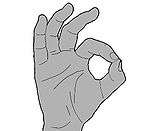OK (gesture)
_hand_only.jpg)
The hand gesture performed by connecting the thumb and index finger into a circle (the O), and holding the other fingers straight or relaxed in the air, is a commonly used form of nonverbal communication. In many parts of the world, it is synonymous with the word OK, denoting approval, agreement, or that all is well. In other contexts or cultures, this same gesture may have different meanings or connotations, including negative or offensive ones.[1]
Unicode symbol U+1F44C (👌) represents this gesture.
Multiple meanings
Positive connotation
The gesture is widely used to mean "all is well" or "good". Where the word "OK" may mean a thing is merely satisfactory or mediocre, as in "the food was OK", the gesture is commonly understood as a signal of approval,[1] and is sometimes used synonymously with the Western "thumbs up" gesture.

As an international underwater diving signal, the OK gesture is used to communicate that there are no problems.[2] It is used as a question, Are you okay?, and its response Yes, I'm OK, or just as a statement, I'm OK. It can be confusing for beginners, because using the "thumbs up" gesture rather than the OK gesture signals that the person making that gesture wants to ascend to the surface.
In the military slang among the conscripts of the Finnish Defence Forces, this gesture is used to denote the number 0, referring to the days left until their honorable discharge. It is also used as a taunt to other conscripts that still have a number of days left.
In basketball, this gesture has been used for the referee signal for a successful three pointer, which is done by raising both hands into the ok gesture (showing three fingers in a distinctive way that would not be mistaken from a successful two points). Sometimes players use this gesture to show they just made a three pointer because of this.
A similar gesture, the Vitarka mudra ("mudra of discussion") is the gesture of discussion and communication (for the number 0) of Buddhist teaching.[3]
Neutral connotation
In Japan, when used with the back of the hand facing down and the circle facing forward, it can mean money, change, or coins.[4]
In Australia and Portugal, it can either mean okay or zero.
In Hong Kong, it can either mean "okay" or "three". "Zero" is represented by a semi-closed fist.
Negative connotation
While the gesture is positive in some countries, in certain parts of middle and southern Europe (although not in Spain or Portugal) the gesture is considered offensive,[5] as in you are a zero or you are nothing. The connotation of zero or worthless is known in France and Belgium, while in some Mediterranean countries such as Turkey, Tunisia, and Greece, in the Middle East, as well as in Brazil and parts of Germany, and several South American countries, it may be interpreted as a vulgar expression: either an insult (you are an asshole), the slang for anus itself, or an offensive reference to homosexuality.[1][6][7]
The gesture is also associated with the circle game, which can range from simple horseplay to deliberate bullying. Players attempt to trick other players into looking at the symbol held below their waist, which then allows them to punch that person.[8]
In most continental European countries, when the sign is placed over the nose, with the nose protruding through the O made by the thumb and forefinger, it means drunk. The origins of this sign may stem from the hand gesture holding a bottle's head while drinking. As a bottle with alcoholic liquid is implied this refers to drinking or the state of being drunk.
In the Arab world, this sign represents the evil eye, and is used as a curse, sometimes in conjunction with verbal cursing.[9]
In the view of some Occultists, it is the number 666, due to the circle and the three fingers behind it.[10] The sign is associated with the Illuminati or Freemasonry by some conspiracy theorists, especially when shown in the media and used by mainstream entertainers.[11][12]
In some areas both the positive "OK" and the negative forms are practiced, which can lead to confusion over which meaning is intended.[1]
References
- 1 2 3 4 Armstrong, Nancy; Wagner, Melissa (2003). Field Guide to Gestures - How to Identify and Interpret Virtually Every Gesture Known to Man. Quirk Books. ISBN 978-1-931686-20-4.
- ↑ Merritt, Anne (2010). "Common Gestures Easily Misunderstood Abroad." Matador Network.
- ↑ Gertrud Hirschi (2000). Mudras: yoga in your hands (illustrated ed.). Weiser Books. p. 140. ISBN 978-1-57863-139-1.
- ↑ Ju Brown, John Brown (2006). China, Japan, Korea Culture and Customs. Ju Brown. p. 55. ISBN 978-1-4196-4893-9.
- ↑ Dangerous Body Language Abroad, by Matthew Link. Posted Jul 26th 2010 01:00 PM. Retrieved on November 17, 2012
- ↑ Body Language. Obscene, to be used with extreme moderation! Retrieved on November 17, 2012
- ↑ Van Edwards, Vanessa (July 2014). "Gestures You Shouldn't Be Making Abroad". Science of People. Retrieved February 14, 2016.
- ↑ The Original Website of the Circle Game
- ↑ "Gestures, Arab Culture" (PDF).. GlobalSecurity.org
- ↑ OK—Sign of the Divine King
- ↑ Masonic Signs in the Media
- ↑ Illuminati Symbols : Satanic 666 Hand Sign
External links
![]() Media related to O gesture with thumb and forefinger at Wikimedia Commons
Media related to O gesture with thumb and forefinger at Wikimedia Commons